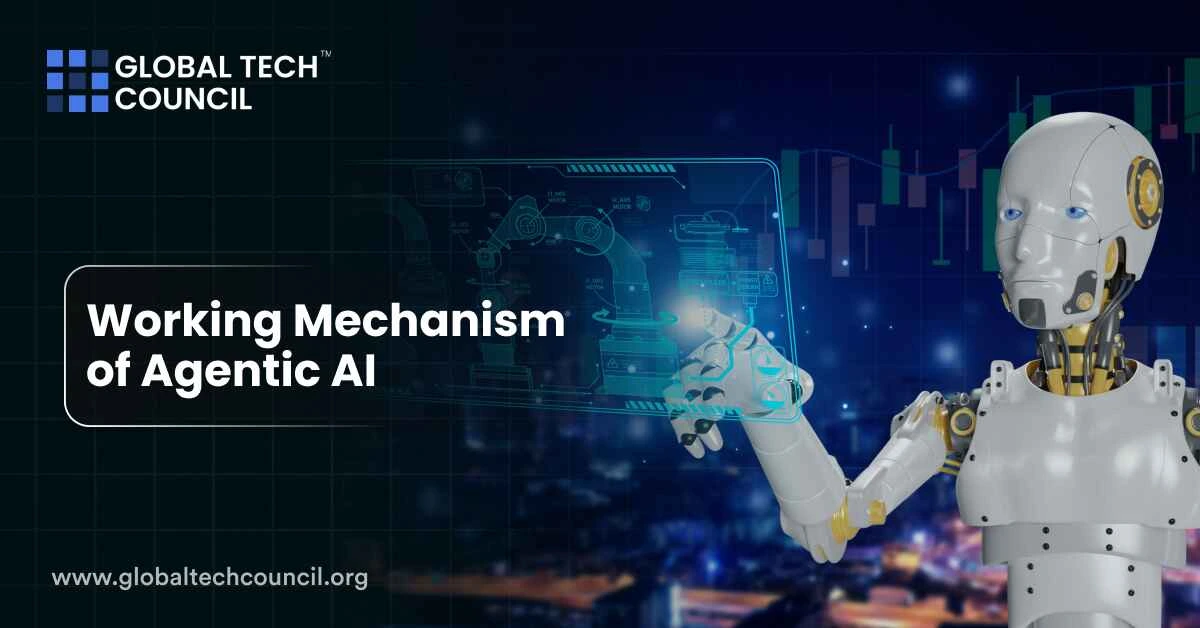
What Exactly Is Agentic AI?
Agentic AI is a kind of artificial intelligence that can act on its own. It doesn’t need someone giving it every little task. These systems notice what’s around them, figure out what to do, and take action—all by themselves.
That makes them different from older types of AI. Traditional models need instructions for everything. Agentic AI handles things alone, even in tough or changing settings.
These systems are good at solving long or complex problems. They don’t just follow commands. They figure things out, step by step, and keep learning as they go.
To fully understand the working mechanism of Agentic AI, a Certified Agentic AI Expert™ certification offers an in-depth exploration of its inner workings.
What Helps Agentic AI Work Without Human Help?
Agentic AI runs on a few core parts. Each one helps the system act in a smart and self-guided way.
Perception And Awareness Of The Environment
First, Agentic AI has to know what’s around it. It uses tools like cameras, sensors, and software to take in data. This can mean anything from tracking roads to reading human language.
For example, in driverless cars, cameras and LiDAR scan the streets. The system turns that data into useful info and decides how to drive safely.
Thinking, Planning, And Making Decisions
After gathering data, the AI starts thinking. It checks different options and picks the best one. This decision-making is built on smart algorithms.
Some of these systems use machine learning. Others might rely on patterns, stats, or both. All of it helps them make the right call in each moment.
Learning New Things Over Time
One of the best things about Agentic AI is its ability to learn. These systems remember what worked and what didn’t. That way, they get better every time they try something.
This kind of learning helps them improve without being reprogrammed. They adapt and grow through use, just like people do.
Taking Action Without Needing Permission
Once a decision is made, the AI system acts. These actions could be physical, like moving a robotic arm, or digital, like fixing a software issue.
The main point is, they don’t wait around for someone to say “go.” They act as needed, based on their training and past experience.
How Does Agentic AI Really Work Step By Step?
The process behind Agentic AI follows a loop. It starts with sensing, moves to decision-making, then action, and ends in learning. Then the cycle begins again.
Here’s how that looks:
- Sensing: The AI gathers data through cameras, sensors, or digital inputs.
- Decision-making: It studies the situation, then figures out the best option.
- Action: It chooses and performs the next step on its own.
- Learning: It checks if the result was good or bad, then improves for next time.
This loop helps the system stay sharp. It doesn’t get stuck. It keeps moving and adjusting in real time. The Certified Agentic AI Developer™ certification equips you with the skills to create and manage AI systems, providing clarity on how they function.
Where Agentic AI Is Being Used Right Now
You’ll find Agentic AI in many industries already. Here are a few places it’s making a difference:
Cybersecurity
Some companies now use Agentic AI to fight off cyber threats. These platforms can spot dangers, respond quickly, and keep systems safe without needing human backup.
For example, tools like GreyMatter scan for problems and act on them using AI rules. This kind of setup saves time and boosts safety.
Office And Business Tasks
Some platforms now let AI agents work together on business tasks. These agents can run systems, manage workflows, and handle routine jobs. That frees up people to focus on bigger things.
The best part? These agents don’t work alone. They team up to get more done, faster.
Customer Support
Forget the old, clunky chatbots. New AI agents can handle more complex support chats. They read tone, remember what customers say, and give better replies.
This makes people feel heard—and it saves companies time and money too.
Self-Driving Vehicles
In cars, Agentic AI helps with driving. These systems watch the road, react to changes, and choose the best driving action.
Brands like Nvidia and GM are working together on this kind of tech. Their goal? Safer, smarter cars that handle the road with little input.
What Are The Common Challenges?
Using Agentic AI comes with a few problems. These systems take a lot of computing strength. That means more servers, more energy, and higher costs.
Security is another worry. If these systems can act alone, they can also be hacked. That risk must be managed.
And then there are ethical questions. What rules should guide these AI systems? Who’s responsible if something goes wrong? These are still open questions for experts to solve.
Conclusion
Agentic AI is a smart, self-guided system built to sense its surroundings, plan ahead, and take action without help. Its process is clear: it observes, decides, acts, and learns. This loop keeps the system running smoothly, even when things change.
Now that we’ve explored its working mechanism, it’s easier to see why Agentic AI is gaining ground in industries that need fast, reliable, and independent systems.
Leave a Reply